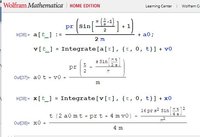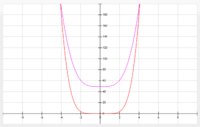Hello! I'd like to ask for clarifications on this exercise. Here's a formula to express acceleration that looks like this:
a = [MATH] \dfrac{pr\left(\sin\left(\frac{{\pi}\left(\frac{t}{s}-1\right)}{2}\right)+1\right)}{2m}+a_0[/MATH]for t (time) in [0, 2*s]
I calculated antiderivatives to find v (velocity) and x (position):
v = [MATH] \dfrac{pr\left(t-\frac{2s\cos\left(\frac{{\pi}\left(\frac{t}{s}-1\right)}{2}\right)}{{\pi}}\right)}{2m}+a_0t+v_0 [/MATH]x = [MATH] \dfrac{pr\left(\frac{t^2}{2}-\frac{4s^2\sin\left(\frac{{\pi}\left(\frac{t}{s}-1\right)}{2}\right)}{{\pi}^2}\right)}{2m}+\dfrac{a_0t^2}{2}+v_0t+x_0 [/MATH]
Now assume a0, v0, x0 = 0.
When replacing t=0, acceleration and velocity are zero, but x isn't. Why?
a = [MATH] \dfrac{pr\left(\sin\left(\frac{{\pi}\left(\frac{t}{s}-1\right)}{2}\right)+1\right)}{2m}+a_0[/MATH]for t (time) in [0, 2*s]
I calculated antiderivatives to find v (velocity) and x (position):
v = [MATH] \dfrac{pr\left(t-\frac{2s\cos\left(\frac{{\pi}\left(\frac{t}{s}-1\right)}{2}\right)}{{\pi}}\right)}{2m}+a_0t+v_0 [/MATH]x = [MATH] \dfrac{pr\left(\frac{t^2}{2}-\frac{4s^2\sin\left(\frac{{\pi}\left(\frac{t}{s}-1\right)}{2}\right)}{{\pi}^2}\right)}{2m}+\dfrac{a_0t^2}{2}+v_0t+x_0 [/MATH]
Now assume a0, v0, x0 = 0.
When replacing t=0, acceleration and velocity are zero, but x isn't. Why?


